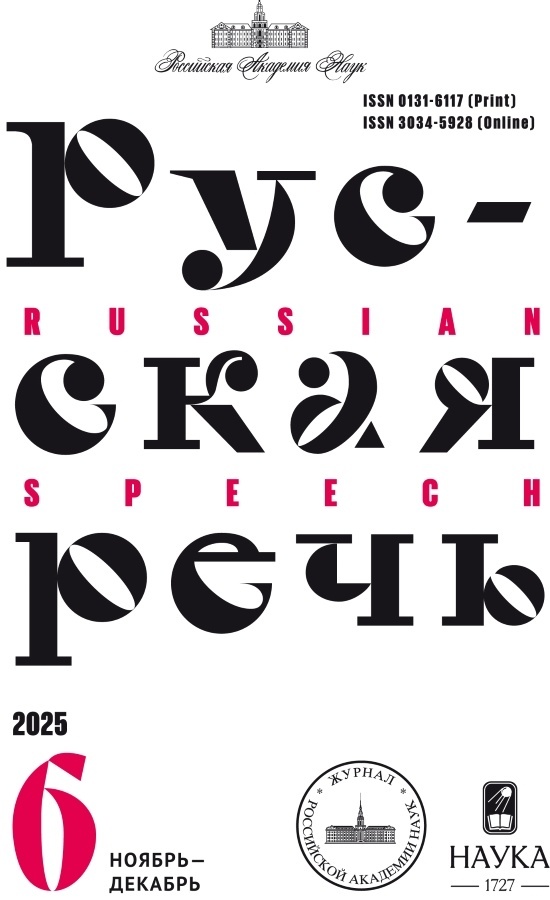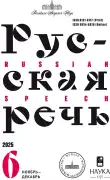No 6 (2025)
Issues of Modern Russian Language
The Problem of Semantic Derivation of the Word "Естественно" ('Naturally')
Abstract
 7-24
7-24


New Vocabulary in the Neological Dictionaries of the 21th Century
Abstract
The paper focuses on the neological reference books created at the Institute for Linguistic Studies of the Russian Academy of Sciences. The article compares the yearbooks that appeared in the new millennium with those that came out in the 20th century. An analysis of the yearbooks of the 21st century has shown that they reflect only the neologisms of a journalistic style. Fiction was outside the scope of consideration. Despite the significant increase in the number of research material sources and the extension of the time period for analyzing sources to the entire calendar year, there are far fewer neologisms in these reference books than in the yearbooks of the twentieth century. As a result of the refusal to continue work on the decade-long dictionary of the 2000s of the new millennium, the tradition of publishing dictionaries recording the usual new formations in the Russian language of each decade, which was initiated by N. Z. Kotelova, was interrupted. Neological reference books, in particular decade-long dictionary, were originally conceived as supplements to explanatory dictionaries. In the new millennium, there were no neographic publications that could serve as a help for compilers of explanatory dictionaries.
 25-40
25-40


Labor in the National Picture of the World of the Russian
Abstract
The lexeme trud ('labor') expresses one of the basic moral and value concepts of any culture and is an important component of the linguistic consciousness of the nation, is reflected in which are proverbs and sayings. Based on the conducted research, it is concluded that work in the worldview of the Russian people is a necessity, which is an important part of life. It is not an internal human need, but is caused by external causes. The main characteristic of labor is severity, while the degree of pleasure from receiving benefits is directly proportional to the effort invested. Hard work is often perceived as a blessing, as it helps to atone for original sin and thereby brings a person closer to God. In this sense, it is contrasted with laziness, which has a devilish nature. A sign of a lazy person is a predilection for idle conversations, aimless loitering and contemplating the work of others. The latter is satisfying. Assessing the amount of labor effort is ambivalent: both laziness and excessive zeal are condemned. The balance of work and leisure is regulated by natural rhythms and church holidays. The attitude to work determines the moral qualities of a person, the degree of his honesty. The reward for work is usually unfair, but the result brings joy. The proverbs about work lack the idea of personal enrichment and accumulation for the next generation. Work is necessary when there is a need to satisfy personal needs. Mental work is valued above physical work and is the prerogative of the older generation. The boundary between women's and men's work is natural, the latter is considered to be of higher quality. In Russian proverbs, the concept of labor correlates with such categories as respect, prosperity, wealth and poverty, laziness, idleness, skill, honesty, etc. Negative characteristics include: the unfairness of the organization and remuneration, excessive severity, large volume, routine.
 41-53
41-53


Eto Mne Otklikayetsya: New Verb Control?
Abstract
The article examines a new construction with the verb otklikat'sya, governing the dative case, which is becoming widespread in modern speech. This construction is presented mainly in colloquial speech and is not yet recorded in standard dictionaries. It is shown that the new control illustrates the concept of syntactic homonymy. The dative case in the new phrase expresses the semantic role of the experiencer - the subject of perception, in contrast to the traditional construction with the dative of the addressee. The complication of the semantic structure of such a phrase is described: the subject of the state, expressed in the dative case, combines the semantics of the "carrier of the state" and the "object" of this state (the one to whom it is directed). In this regard, the combinability possibilities of the verb otklikat'sya are expanding: the role of the subject in statements with such a construction can be played by abstract nouns, denoting what is to be perceived. It is noted that a change in the semantic role of the dative case with the verb otklikat'sya leads to a change in the nature of control: from a weakly controlled form, the dative case becomes a strongly controlled case form, used to express the meaning of the subject of perception. It is indicated that the orientation towards the subjective principle in such combinations is supported by the ability of the verb otklikat'sya to control the prepositional case with the preposition v and the genitive case with the preposition u, which indirectly designates the subject of perception through an appeal to his inner world. The author suggests that the emergence of a new construction is due to the action of the analogy mechanism: the meaning of the verb otklikat'sya is formed under the influence of the meaning and syntactic "behavior" of the verb nravit'sya. Thus, we can trace the development of a new meaning for the verb otklikat'sya (as well as for its synonym otzyvat'sya), including the semes "response action", "emotional response", which are absent in the meaning of the verb nravit'sya.
 54-66
54-66


Neoderivatives with the Formant -ing in the Language of Modern Russian Media
Abstract
In modern media discourse, nouns ending in -ing are actively used. Yet, they are not borrowings, they are new derivative words. The subject of research in this article is non-derivatives formed from Russian motivational foundations. The authors pay attention to the status of the formant -ing in the grammatical system of the Russian language. The aim of the study is to identify the word-forming potential, role and functions of the morpheme -ing, to show the process of integration of a foreign-language suffix into the Russian word-formation system. The considered derivatives are a product of word formation on Russian soil. The motivating basis of ing neoderivatives are usually nouns of specific semantics (izbing - from izba, boloting - from boloto = swamp, shashlyching - from shashlyk), less often verbs and deverbatives (rubing - from rubit' = chop wood; propoling - from propolka = weeding). Derivative nouns are formed according to the active word-formation model "noun + -ing". They have a processual-event meaning, which is introduced by the word-formation affix -ing. This morpheme, unlike the suffixes "-a-niye" and "-yeniye", which participate in the formation of verbal nouns, can be attached to the motivating stems of nouns. Neologisms with the formant -ing perform a nominative function, but they have a bright expressiveness, being usually individually authored. Word-creation with the formant -ing is widely used in ironic poetry. The study demonstrates the growing derivational potential of the morpheme -ing based on the material of Russian mass media and the Internet, and shows a grammatical renewal of the Russian lexicon.
 67-80
67-80


From the History of the Russian Language
Neologization of the Russian Language in the Second Half of the 19th Century: on the History of Some Abstract Nouns
Abstract
The article is devoted to the analysis of the process of neologization of the Russian language in the second half of the XIX century in connection with neo-conceptualization, by which we mean the formation of new concepts or the transformation of previously received ideas about the world. Russian classical writers (V. G. Korolenko, N. S. Leskov, L. N. Tolstoy, A. P. Chekhov) epistolary served as the research material in comparison with the data of dictionaries of the XIX century, the National Corpus of the Russian language and other sources. Two types of lexical innovations of the era are considered: 1) neologisms that verbalized concepts of a pan-European nature, 2) neologisms that verbalized concepts specific to the Russian national consciousness. Appearance of some abstract nouns is explained by a combination of extralinguistic and linguistic factors: the formation or updating of a concept and the action of an intra-system law: filling in lexical and word-formation gaps. The semantics and morphological structure of lexical units of different thematic groups, features of their use in speech and lexicographic fixation are analyzed.
 81-95
81-95


Latin Inclusions in Slavic Versions of Caesar Baronius "Ecclesiastical Annals"
Abstract
The article focuses on Latin inclusions in the Slavic versions of Caesar Baronius "Ecclesiastical Annals". The author analyzes main characteristics of the inclusions in Piotr Skarga Polish translation and the methods of their transmission in Church Slavonic translations from the late 17th - early 18th centuries. The analysis discovers that the version preserved in a Russian State Library manuscript (f. 256, no. 15, 1689) tends to translate inclusions or adapt them grammatically as loanwords, while the 1719 edition prefers transliteration and reproduction of Latin forms. Within grammatical adaptation, a change in grammatical gender and syntactic re-invention in context are possible. When the insertion is accompanied by an explanation, correlations with the translated Polish text may be different; additional comments are also possible whereas Skarga does not have any. As a specific group, the author analyzes anthroponyms; in Polish translation, they can either have all features of the inclusions or demonstrate the results of phonetic and/or grammatical adaptation. Predominance of grammatically adapted forms and graphic-phonetic variation both characterize East Slavic versions. From this point of view, there is an interesting contrast between the manuscripts of the Russian State Library f. 256 no. 15 and no. 16: the former presents a tendency towards graphic Greekization, while in the latter, personal names may reflect a colloquial dialect pronunciation. In general, manuscript no. 15 demonstrates tendencies common for the Chudov circle translations from the second half of the 17th century when transmitting Latin inclusions.
 96-110
96-110


The Language of Fiction
Stylistic Similarities and Differences of Russian Interwar Novels Through the Prism of the Most Frequent Words
Abstract
The article deals with the analysis of the most frequent words in the corpus of Russian interwar prose. The starting point is a stylistic analysis using one of the most tested and reliable stylistic tools, Burrows's Delta, with the help of which we performed the clustering of the interwar period novels. Within the framework of this article, it is proposed to analyze the most frequent words in these novels and compare the results with the Delta data. Particular attention is paid to grammatical categories, the study of features directly expressed in frequency of word usage. The objective is to identify what the frequency of these features can say about the stylistic features of the analyzed texts; their similarities and differences. For this purpose, we introduced the concepts of high, neutral and low frequency of a word in a certain text. Based on the calculations, it is found that the styles of Shmelev and Pilnyak are sharply marked, for all 25 words the frequency level coincides in Leonov's "Road to the Ocean" and "Skutarevsky". The results also allow us to record the competition of prepositions, conjunctions and pronouns. None of the texts examined has a combination of equally high or equally low proportions of the prepositions "v" and "na". In addition, it is concluded that the high frequency of "kak" correlates with the metaphorical poetics of Olesha, five later novels by Nabokov, Fedin, Shmelev and Green, and that the abundance of the pronoun "ty" marks texts with a large role of dialogue and the informal, unofficial nature of this dialogue (Gaidar, Leonov, Platonov). The frequency of the pronoun "ona" is globally associated with the high role of the heroines in the narrative, but it turns out that the level of frequency for "The Shining World" is significantly higher than for "Running on the Waves".
 111-127
111-127













